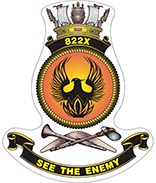822X Squadron
Commanding Officer: Commander William Veale
822X Squadron's mission is to conduct experimentation and evaluation activities with contemporary Unmanned Aircraft Systems (UAS) and advanced payloads to develop operational knowledge and experience, develop orders and procedures supporting safe UAS operations, and to assess UAS capability options that support integrated warfare outcomes for the future Fleet.
The Navy UAS Development Unit (NUASDU) was formed in late 2012 with the primary purpose of conducting experimentation activities with an exemplar UAS in order to develop an in-depth understanding of the potential capabilities of MTUAS. Secondary tasks involved establishing policy and procedures, developing and testing crew models, tactics, understanding support requirements, gathering cost of ownership data and informing future acquisition projects that may have a UAS requirement. Unit strength was a mere five personnel.
NUASDU commenced flight operations from Jervis Bay Airfield (near HMAS Creswell) in March 2013 with a leased ScanEagle UAS supported by contract staff from Insitu Pacific. After successful land based trials, approval was granted to embark the ScanEagle into HMAS Parramatta for an initial embarked demonstration. On 8 May 2013, ScanEagle AV1422, call-sign ScanEagle 22 became the first Maritime Tactical UAS operated from an Australian warship by a Navy crew member.
With a requirement for more in-depth embarked evaluations to explore MTUAS concepts of operation, Navy acquired two ScanEagle systems in June 2015 and expanded to 13 personnel to support two deployable UAS crews, managed by a small executive. To recognise the maturing of the evaluation program, the unit was renamed the Navy UAS Unit (NUASU) and introduced a new call sign - 'Omen'. The Omen call sign is used for all Navy UAS to indicate to other airspace users that the aircraft is unmanned.
To date, evaluation activities with the ScanEagle system have been conducted from land bases at Jervis Bay, Beecroft Weapons Range and a three month deployment to Christmas Island. Embarked operations have been conducted from several Navy ships including HMA Ships Parramatta, Choules and Newcastle, and the Multi-role Aviation Training Vessel MV Sycamore. The HMAS Newcastle embarkation and subsequent deployment to Operation MANITOU in 2017 represented the first deployment of an Australian Navy UAS to an operational area, albeit for operational evaluation purposes.
The Schiebel Camcopter S-100 UAS was acquired by Navy in late 2016 to broaden the Navy's understanding of Vertical Take off and Landing (VTOL) UAS. The S-100 was accepted into Navy service on 30 April 2018.
NUASU expanded to 32 personnel, enabling the deployment of one ScanEagle flight and one S-100 Flight to sea for embarked evaluation activities while maintaining one ScanEagle Flight at Nowra for training and land-based experimentation activities.
In June 2018, then Chief of Navy, Vice Admiral Barrett, AO, CSC, RAN announced his decision to commission Navy's first Maritime Tactical UAS Squadron, 822X Squadron, signalling a new era in Maritime Aviation operations. This is the first time the 'X' nomenclature has been used by the RAN, and reflects the Squadron's experimental and developmental nature.
822X Squadron commissioned on 25 October 2018 at a ceremony at HMAS Albatross.
Navy Unmanned Aircraft Systems (UAS)
Navy has an association with Unmanned Aircraft Systems dating back to the 1950s, when unmanned target towing aircraft were introduced into military service to support training operations. Navy operated the Jindivik, Turana and Kalkara UAS in this role for over five decades.
Many navies are exploring the use of Maritime Tactical UAS (MTUAS) from ships in support of maritime operations, primarily in Intelligence, Surveillance and Reconnaissance (ISR) roles taking advantage of the UASs long endurance, covert nature and high quality optical sensors. The RAN has been conducting experimentation, demonstrations and trials since 2012, aimed at increasing Navy's familiarity and experience with Maritime Tactical UAS.
UAS Roles
Unmanned systems specialise in roles described as dull, dirty or dangerous. Navy seeks to complement the existing capabilities provided by its advanced MH-60R Seahawk and MRH90 Taipan aircraft, taking advantage of the inherent MTUAS strengths; sensor capabilities, covertness and long endurance.
The core role of tactical UAS is Intelligence, Surveillance and Reconnaissance (ISR). Presently, high quality video and still imagery is provided to the operator in near realtime significantly improving battlespace awareness.
In a Naval context, UAS may undertake roles that contribute to tasks such as:
- Surface Warfare
- Amphibious Warfare
- Anti-Submarine Warfare
- Fire Support
- Search and Rescue
- Humanitarian Assistance and Disaster Relief
- Interdiction Operations
- Force Protection
Navy is exploring innovative uses of small commercially available UAS for hull and mast inspections, harbour force protection, boarding party support, man overboard assistance and support to public relations tasking. Most of these tasks seek to utilise the UAS technology to reduce risks to Navy personnel.





